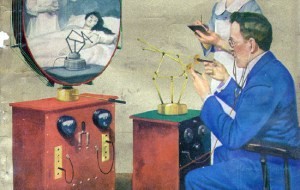
 Diagnosis "by radio", cover of Science and Invention, 1925.
Diagnosis "by radio", cover of Science and Invention, 1925.
We can distinguish four periods and different milestones in the development of French telemedicine. The pioneering phase, which began in the 1980s, is particularly embodied by Professor Louis Lareng (who also co-founded the Samu in 1968) who created the European Institute of Telemedicine in 1989. This phase, which saw the emergence of the very first experiments, lasted until the 2000s.
Institutional and legal recognition came in 2004, with the law on health insurance, which defined telemedicine at the minimum. This definition was extended by Article 78 of the "Hospital, Patients, Health and Territories" (HPST) law of July 21st, 2009: telemedicine is a form of medical practice using information and communication technologies and allows, at a distance, to make a diagnosis, obtain a specialist opinion, monitor the condition of patients, etc. Decree no. 2010-1229 of 19 October 2010 defines five acts of telemedicine: teleconsultation, tele-expertise, tele-monitoring, tele-assistance and the response provided via medical regulation by the SAMU/Centre 15, which existed previously.
After the HPST law and the 2010 decree, a new phase of experimentation began, with a more sustained period starting with the ETAPES programme (Expérimentations de Télémédecine pour l'Amélioration des Parcours en Santé - Telemedicine experiments for the improvement of health care pathways), which began in 2014. But all these experiments were only a modest preliminary to the deployment institutionally and financially supported by the State. The 2010s were therefore marked by the slow development of telemedicine until the introduction of pricing and reimbursement for teleconsultation in September 2018 by the Health Insurance. In September 2019, one year after the implementation of reimbursement by the CNAM, only a little less than 2,000 doctors are practising teleconsultation, i.e. less than 1% of all practitioners, all types of practice combined. About 60,000 teleconsultations reimbursed by the social security system have been undertaken, out of the 500,000 initially planned.
Following this period, a phase of sudden acceleration in the use of telemedicine began in March 2020, in connection with the Covid-19 epidemic. It is characterised by the temporary relaxing of the regulatory framework for teleconsultation. This means 100% reimbursement by the CNAM for people with Covid, the possibility of carrying out teleconsultations by telephone, reimbursement outside the coordinated care pathway, etc. Without prior training, many doctors have practised telemedicine off-the-cuff, facing unprecedented difficulties (adapting clinical practices at a distance, new modes of communication, etc.).
Before the quarantine of the French population in the spring of 2020, very few health professionals had practised telemedicine and carried out teleconsultations. At the time, they represented only 0.1% of all the consultations. With the epidemic, their relative weight rises very quickly, reaching 25% during the first quarantine. In April 2020 alone, there were 4.5 million teleconsultations reimbursed by the Health Insurance. However, at the end of the same year, after the quarantine phases, only 6% of consultations were carried out remotely.
These different periods of development of French telemedicine are also marked by the central role played by the French Society for Digital Health (SFSD). Since its creation in 2006, thanks to the commitment and influence of its representatives, such as Dr. Pierre Simon, the SFSD has successfully defended a clinical conception of telemedicine with various institutional and political representative bodies. It has also played an advisory role for a whole series of operators who, at a local level, contribute directly to the development of telemedicine projects. Since the second half of the 2010s, the SFSD considers informing but above all training practitioners on telemedicine as a major stake in the spreading of this practice and has thus actively been working on this aspect.
Read more in the dictionary : Telemedicine(history)- Emergency medicine
Read the paper in french : Télémédecine
Références :
Mathieu-Fritz Alexandre, Le praticien, le patient et les artefacts. Genèse des mondes de la télémédecine, Paris, Presses des Mines, 2021.
Mathieu-Fritz Alexandre, Gaglio Gérald, « À la recherche des configurations sociotechniques de la télémédecine. Revue de littérature des travaux de sciences sociales », Réseaux, vol. 36, n° 207, janvier-février 2018, p. 27-63.
To quote this paper : Alexandre Mathieu-Fritz, "Telemedicine and Covid-19" in Hervé Guillemain (ed.), DicoPolHiS, Le Mans Université, 2021.